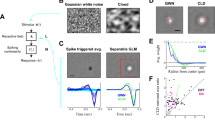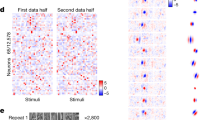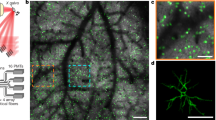Abstract
Statistical dependencies in the responses of sensory neurons govern both the amount of stimulus information conveyed and the means by which downstream neurons can extract it. Although a variety of measurements indicate the existence of such dependencies1,2,3, their origin and importance for neural coding are poorly understood. Here we analyse the functional significance of correlated firing in a complete population of macaque parasol retinal ganglion cells using a model of multi-neuron spike responses4,5. The model, with parameters fit directly to physiological data, simultaneously captures both the stimulus dependence and detailed spatio-temporal correlations in population responses, and provides two insights into the structure of the neural code. First, neural encoding at the population level is less noisy than one would expect from the variability of individual neurons: spike times are more precise, and can be predicted more accurately when the spiking of neighbouring neurons is taken into account. Second, correlations provide additional sensory information: optimal, model-based decoding that exploits the response correlation structure extracts 20% more information about the visual scene than decoding under the assumption of independence, and preserves 40% more visual information than optimal linear decoding6. This model-based approach reveals the role of correlated activity in the retinal coding of visual stimuli, and provides a general framework for understanding the importance of correlated activity in populations of neurons.
This is a preview of subscription content, access via your institution
Access options
Subscribe to this journal
Receive 51 print issues and online access
$199.00 per year
only $3.90 per issue
Buy this article
- Purchase on Springer Link
- Instant access to full article PDF
Prices may be subject to local taxes which are calculated during checkout




Similar content being viewed by others
Change history
19 September 2008
In the online-only extended Methods, two equations were corrected on 19 September 2008. Please see the erratum at the end of the PDF for details.
References
Mastronarde, D. N. Correlated firing of retinal ganglion cells. Trends Neurosci. 12, 75–80 (1989)
Meister, M., Lagnado, L. & Baylor, D. A. Concerted signaling by retinal ganglion cells. Science 270, 1207–1210 (1995)
Shadlen, M. & Newsome, W. The variable discharge of cortical neurons: implications for connectivity, computation, and information coding. J. Neurosci. 18, 3870–3896 (1998)
Truccolo, W., Eden, U. T., Fellows, M. R., Donoghue, J. P. & Brown, E. N. A point process framework for relating neural spiking activity to spiking history, neural ensemble and extrinsic covariate effects. J. Neurophysiol. 93, 1074–1089 (2004)
Paninski, L. Maximum likelihood estimation of cascade point-process neural encoding models. Network Comp. Neural Syst. 15, 243–262 (2004)
Warland, D., Reinagel, P. & Meister, M. Decoding visual information from a population of retinal ganglion cells. J. Neurophysiol. 78, 2336–2350 (1997)
Dan, Y., Alonso, J. M., Usrey, W. M. & Reid, R. C. Coding of visual information by precisely correlated spikes in the lateral geniculate nucleus. Nature Neurosci. 1, 501–507 (1998)
Panzeri, S., Golledge, H., Zheng, F., Tovee, M. P. & Young, M. J. Objective assessment of the functional role of spike train correlations using information measures. Vis. Cogn. 8, 531–547 (2001)
Nirenberg, S., Carcieri, S., Jacobs, A. & Latham, P. Retinal ganglion cells act largely as independent encoders. Nature 411, 698–701 (2001)
Schneidman, E., Bialek, W. & Berry, M. J. Synergy, redundancy, and independence in population codes. J. Neurosci. 21, 11539–11553 (2003)
Nirenberg, S. & Latham, P. E. Decoding neuronal spike trains: how important are correlations? Proc. Natl Acad. Sci. USA 100, 7348–7353 (2003)
Averbeck, B. B. & Lee, D. Coding and transmission of information by neural ensembles. Trends Neurosci. 27, 225–230 (2004)
Latham, P. & Nirenberg, S. Synergy, redundancy, and independence in population codes, revisited. J. Neurosci. 25, 5195–5206 (2005)
Schneidman, E., Berry, M., Segev, R. & Bialek, W. Weak pairwise correlations imply strongly correlated network states in a neural population. Nature 440, 1007–1012 (2006)
Shlens, J. et al. The structure of multi-neuron firing patterns in primate retina. J. Neurosci. 26, 8254–8266 (2006)
Plesser, H. & Gerstner, W. Noise in integrate-and-fire neurons: From stochastic input to escape rates. Neural Comput. 12, 367–384 (2000)
Simoncelli, E. P., Paninski, L., Pillow, J. & Schwartz, O. in The Cognitive Neurosciences 3rd edn (ed. Gazzaniga, M.) 327–338 (MIT, 2004)
Frechette, E. S. et al. Fidelity of the ensemble code for visual motion in primate retina. J. Neurophysiol. 94, 119–135 (2005)
Okatan, M., Wilson, M. & Brown, E. Analyzing functional connectivity using a network likelihood model of ensemble neural spiking activity. Neural Comput. 17, 1927–1961 (2005)
Rigat, F., de Gunst, M. & van Pelt, J. Bayesian modelling and analysis of spatio-temporal neuronal networks. Bayes. Anal. 1, 733–764 (2006)
DeVries, S. H. Correlated firing in rabbit retinal ganglion cells. J. Neurophysiol. 81, 908–920 (1999)
Pillow, J. W., Paninski, L., Uzzell, V. J., Simoncelli, E. P. & Chichilnisky, E. J. Prediction and decoding of retinal ganglion cell responses with a probabilistic spiking model. J. Neurosci. 25, 11003–11013 (2005)
Shapley, R. M. & Victor, J. D. The effect of contrast on the transfer properties of cat retinal ganglion cells. J. Physiol. 285, 275–298 (1978)
Harris, K., Csicsvari, J., Hirase, H., Dragoi, G. & Buzsaki, G. Organization of cell assemblies in the hippocampus. Nature 424, 552–556 (2003)
Paninski, L., Fellows, M., Shoham, S., Hatsopoulos, N. & Donoghue, J. Superlinear population encoding of dynamic hand trajectory in primary motor cortex. J. Neurosci. 24, 8551–8561 (2004)
Litke, A. M. et al. What does the eye tell the brain? Development of a system for the large scale recording of retinal output activity. IEEE Trans. Nucl. Sci. 51, 1434–1440 (2004)
Watanabe, M. & Rodieck, R. W. Parasol and midget ganglion cells of the primate retina. J. Comp. Neurol. 289, 434–454 (1989)
Segev, R., Goodhouse, J., Puchalla, J. & Berry, M. J. Recording spikes from a large fraction of the ganglion cells in a retinal patch. Nature Neurosci. 7, 1155–1162 (2004)
Pillow, J. W. & Latham, P. in Advances in Neural Information Processing Systems 20 (eds Platt, J. C., Koller, D., Singer Y. & Roweis S.) 1161–1168 (MIT, 2008)
Meister, M. & Berry, M. J. The neural code of the retina. Neuron 22, 435–450 (1999)
Acknowledgements
We thank M. Bethge, C. Brody, D. Butts, P. Latham, M. Lengyel, S. Nirenberg and R. Sussman for comments and discussions; G. Field, M. Greschner, J. Gauthier and C. Hulse for experimental assistance; M. I. Grivich, D. Petrusca, W. Dabrowski, A. Grillo, P. Grybos, P. Hottowy and S. Kachiguine for technical development; H. Fox, M. Taffe, E. Callaway and K. Osborn for providing access to retinas; and S. Barry for machining. Funding was provided a Royal Society USA/Canada Research Fellowship (J.W.P.); NSF IGERT DGE-03345 (J.S.); NEI grant EY018003 (E.J.C., L.P. and E.P.S.); Gatsby Foundation Pilot Grant (L.P.); Burroughs Wellcome Fund Career Award at the Scientific Interface (A.S.); US National Science Foundation grant PHY-0417175 (A.M.L.); McKnight Foundation (A.M.L. and E.J.C.); and HHMI (J.W.P., L.P. and E.P.S.).
Author information
Authors and Affiliations
Corresponding author
Supplementary information
Supplementary Information 1
The file contains Supplementary Discussion with Supplementary Figures S1-S10 and Legends. (PDF 2884 kb)
Rights and permissions
About this article
Cite this article
Pillow, J., Shlens, J., Paninski, L. et al. Spatio-temporal correlations and visual signalling in a complete neuronal population. Nature 454, 995–999 (2008). https://doi.org/10.1038/nature07140
Received:
Accepted:
Published:
Issue Date:
DOI: https://doi.org/10.1038/nature07140
This article is cited by
-
An actor-model framework for visual sensory encoding
Nature Communications (2024)
-
Population coding of strategic variables during foraging in freely moving macaques
Nature Neuroscience (2024)
-
An artificial visual neuron with multiplexed rate and time-to-first-spike coding
Nature Communications (2024)
-
Retinal spike train decoder using vector quantization for visual scene reconstruction
Complex & Intelligent Systems (2024)
-
A distributed and efficient population code of mixed selectivity neurons for flexible navigation decisions
Nature Communications (2023)
Comments
By submitting a comment you agree to abide by our Terms and Community Guidelines. If you find something abusive or that does not comply with our terms or guidelines please flag it as inappropriate.



